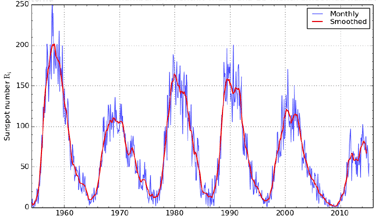
Short Wave Propagation |
IntroductionUnlike local radio broadcasting on the VHF (FM) and medium wave bands, short-wave reception relies upon the refraction of signals from layers of gas hundreds of kilometers above the Earth's surface (known as the ionosphere). These layers of gas are 'excited' when the Sun shines on them, changing their characteristics: some of them become more reflective to radio signals when subject to solar radiation whereas some start to absorb radio signals. This is why some short-wave frequencies are good for night-time reception and others for the day-time. Sunset and sunrise present some other interesting opportunities as both the night-time and day-time layers of ionisation begin to swap over. This complex interplay of radio signals and layers of the Earth's atmosphere is usually termed 'propagation'. In General...
In general, radio frequencies below about 12 MHz (or 12000 kHz) are refracted by layers of gas which appear during the night, whereas frequencies above about 9 MHz (or 9000 kHz) are refracted by the layers of gas which appear during daylight. Frequencies below about 5 MHz (or 5000 kHz) are largely absorbed by the day-time layers. The diagram on the right shows which frequencies generally are best for short-wave reception at different times of the day. Above 12 MHz, conditions during the day are usually good but can be very variable especially as you climb higher in frequency: the reasons for this are described below. More Specifically...Although it is possible to generalise about how radio propagation will affect short-wave reception, the actual conditions will vary from day to day, month to month and from year to year. The gases in the ionosphere are affected by the Sun's radiation and like the Earth, the Sun has weather which consists of storms as well as a winter and summer 'seasons' (known as the Solar cycle). Help is at Hand...Thankfully, help is at hand. All the hard work associated with interpreting the impact that Solar weather conditions are having on short-wave radio reception has been done for you. The chart on the left (provided by rigreference.com) shows the calculated short-wave propagation conditions and estimates which frequencies are likely to provide good, fair or poor reception today during the day and at night for the various short wave bands. The effect of Solar storms can be very peculiar. In addition, even the weather on the planet Earth itself can cause odd propagation anomolies. In some instances solar storms or other propagation anomolies will cause improved short-wave radio reception on the Earth. In other circumstances they may cause a complete blackout of short-wave radio reception. In extreme conditions, the radiation from the Sun can actually cause damage to electrical systems orbiting the Earth (e.g. satellites) and to ground based infrastructure too (often electricity distribution or telecommunications cables). Solar radiation, as well as affecting radio reception, also causes some of nature's wonders and in particular the Aurora Borealis (and less well known Aurora Australis) are both caused by gases and radiation escaping from the Sun. So now you know! |
